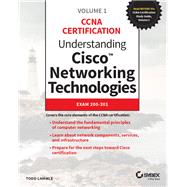Leading Cisco authority Todd Lammle helps you gain insights into the new core Cisco network technologies
Understanding Cisco Networking Technologies is an important resource for those preparing for the new Cisco Certified Network Associate (CCNA) certification exam as well as IT professionals looking to understand Cisco’s latest networking products, services, and technologies. Written by bestselling author and internationally recognized Cisco expert Todd Lammle, this in-depth guide provides the fundamental knowledge required to implement and administer a broad range of modern networking and IT infrastructure.
Cisco is the worldwide leader in network technologies—80% of the routers on the Internet are Cisco. This authoritative book provides you with a solid foundation in Cisco networking, enabling you to apply your technical knowledge to real-world tasks. Clear and accurate chapters cover topics including routers, switches, controllers and other network components, physical interface and cabling, IPv6 addressing, discovery protocols, wireless infrastructure, security features and encryption protocols, controller-based and software-defined architectures, and more. After reading this essential guide, you will understand:
- Network fundamentals
- Network access
- IP connectivity and IP services
- Security fundamentals
- Automation and programmability
Understanding Cisco Networking Technologies is a must-read for anyone preparing for the new CCNA certification or looking to gain a primary understanding of key Cisco networking technologies.








